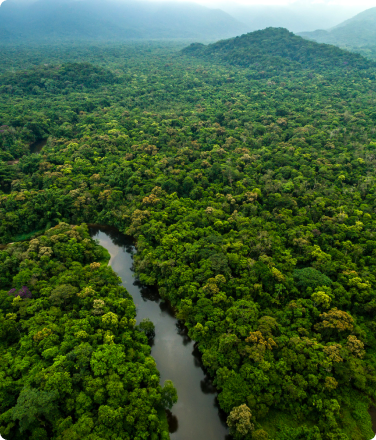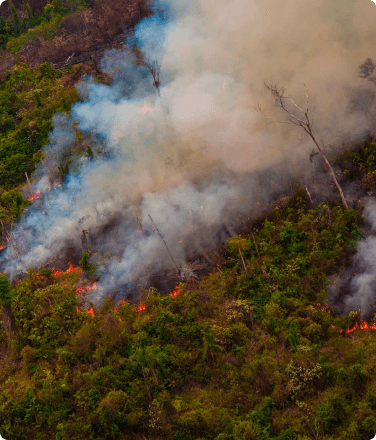Indigenous women and children marching in Brazil for their future during the III Indigenous Women’s March in Brasilia, 2023.
IMAGE CREDIT: Isis Medeiros/Rainforest Foundation US
- The III Indigenous Women’s March in the Brazilian capital of Brasilia brought together over 6,000 female leaders from various Indigenous communities worldwide.
- Women marchers called on the world to protect their biomes from the threats they are currently facing, and to bring to light issues such as violence against women and gender equality.
- In addition to supporting women’s delegations traveling to Brasilia, RFUS had a staff member on-site assisting the Indigenous women from Roraima.
On September 10, Indigenous women from across the globe gathered in the Brazilian capital of Brasilia for the III Indigenous Women’s March from September 11-14 aimed to raise awareness about threats to the lands they represent. The event brought together more than 6,000 Indigenous women from all over Brazil, in addition to Malaysia, Uganda, the United States, Peru, Kenya, New Zealand, Bangladesh, Russia, Indonesia, Guatemala, and Finland.
Brazilian Indigenous minister Sonia Guajajara stands with FUNAI director Joenia Wapichana and senator Celia Xakriabá, along with other women lawmakers, outside Congress during the III Indigenous Women’s March in Brasilia. 2023. Photo Credit: Isis Medeiros/Rainforest Foundation US
Women march in Brasilia during the III Indigenous Women’s March. 2023.
Photo Credit: Isis Medeiros/Rainforest Foundation US
Kelliane Wapichana, women’s secretary of CIR, speaks to the crowd at the III Indigenous Women’s March in Brasilia. 2023. Photo Credit: Isis Medeiros/Rainforest Foundation US
GALLERY CREDIT: Isis Medeiros/Rainforest Foundation US
For Kelliane Wapichana, 31, the idea of working with thousands of representatives of Indigenous peoples from around the globe is hardly intimidating. As the youngest ever women’s secretary of the Indigenous Council of Roraima (CIR), she is used to organizing across languages and cultural barriers.
Encompassing 55,000 people across 10 language groups, CIR is one of the largest regional representative organizations in Brazil. It is also one of the most distant from the centers of power, based in the far-flung state of Roraima, which lies along the northernmost border with Guyana and Venezuela. It stands to reason, then, that for Kelliane, one of the biggest challenges in preparing to march on the capital were logistical. Plane travel to and from the region is expensive, with ticket prices ranging between USD$400 to USD$1200, the latter nearly 3x average monthly wages in the region. Raising the funds to transport a delegation of 18 regional leaders is a major hurdle. But for Kelliane, the opportunity to join thousands of Indigenous women to march on the capital cannot be overestimated.
“Women are always on the front lines. And when we come together, we have enormous strength to fight for what is ours” – Kelliane Wapichana
Women at the Center of Power
This was the first Indigenous Women’s March since the arrival of President Lula da Silva in January, and the subsequent appointment of multiple Indigenous women to office. Among them Joenia Wapichana, a former lawyer for CIR, who became the first woman and the first Indigenous person to direct the National Indigenous Peoples’ Foundation (FUNAI), and Sonia Guajajara, Brazil’s first-ever minister for Indigenous Peoples.
Organized by Brazil’s National Articulation of Indigenous Ancestral Women Warriors (ANMIGA), the program featured a diverse lineup of panel discussions, working groups, cross-cultural ceremonies, and culminated with a march on the capital.
On the first day of programming, Sonia, Joenia, and Célia Xacriabá, Indigenous congresswoman, invited 500 Indigenous marchers inside the National Congress for a historic event.
“We are extremely capable of being at the front of this room, of participating in these dialogues, of sitting at the table as equals, and proposing our own ideas,” said Joenia, as the sound of ceremonial maracas and applause ricocheted off the walls of the lower house.
“At the heart of this march is a powerful call for equal rights for Indigenous women. These women have faced countless challenges and injustices throughout their lives, but they refuse to be silenced” -Brazil’s National Articulation of Indigenous Ancestral Women Warriors (ANMIGA)
The women of CIR brought traditional food to sustain themselves during the march: manioc flour, dried fish and meat, hot peppers, and cassava bread, in addition to heirloom beans from their Equator Prize-winning seedbank. Photo Credit: Isis Medeiros/Rainforest Foundation US
Back at camp, the women of CIR pray together before eating the food they brought from home. Photo Credit: Isis Medeiros/Rainforest Foundation US
Naiza Macuxí, of Roraima state, preparing for the III Indigenous Women’s March in Brasilia. 2023. Photo: Isis Medeiros l Rainforest Foundation US
GALLERY CREDIT: Isis Medeiros/Rainforest Foundation US
A Temporary Village
The women set up camp in a public park in the heart of Brasilia, pitching their own tents and sharing meals with food brought from home—for the women from Roraima, that meant manioc flour, dried fish and meat, hot peppers, and cassava bread. The camp became a sprawling temporary village in its own right, a place where women could recharge between events and connect with one another. Teenagers smoked ceremonial pipes and sang harmonies together at night, and children played in the enormous kids’ area, which featured a very popular trampoline.
Just like in a real village, nearly all delegations were represented by a mix of elders and youth. Among the elders was Mariana Tobías, a Macuxi woman from northern Brazil.
From the day Mariana, 75, was born, her grandmother knew she would be a shaman, or pajé. Some of her earliest memories are of being taught to heal people and call up visions using sacred plants in Raposa Serra do Sol, the largest Indigenous territory in Brazil.
In addition to holding deep traditional knowledge of plants and spirits, Pajé Mariana has been witness to years of struggle, and she holds this history in her body.
“I’ve felt the barrel of a gun right here, against my rib cage,” she says, gesturing at her back. She’s seen the inside of a jail cell, and has healed her husband after he was shot by armed guards hired by rice farmers during the struggle for the titling of the Raposa Serra do Sol territory, in 2008. Gaining legal recognition of their lands is an ongoing struggle for the Macuxi and many other Indigenous peoples throughout Brazil.
“When we talk about Pajé Mariana, we are talking about a woman who gives us strength,” says Kelliane, who also hails from Raposa Serra do Sol. “For us, she is a big tree—a tree who teaches us, who advises us, who protects us from evil and who strengthens us with her prayer.”
Women hold a banner that reads “The Future is Indigenous” during the III Indigenous Women’s March in Brasilia. 2023. Photo Credit: Isis Medeiros/Rainforest Foundation US
Pajé Mariana, 75, holds the resin of the sacred Maruai plant, in Brasília, during the III Indigenous Women’s March. 2023.
GALLERY CREDIT: Isis Medeiros/Rainforest Foundation US
“Nothing was given to us”
By the fourth and final day of the march, Kelliane lost her voice from a bad cold. The crowded camp hardly seemed like a good place to rest. But between Pajé Mariana’s prayer and the herbal remedies brought from home, Kelliane recovered enough to stand over the crowd and shout into a microphone, her voice ragged with emotion.
“Nothing was given to us, everything was won. The women who came before us faced bullets and death to gain our rights in the Constitution, and many of our leaders died in the struggle” – Kelliane Wapichana
Among banners and signs, the women around her joined her in demanding their rights, and rejected current legal threats—such as Bill 2903/2023, recently approved by the Federal Senate, and the Marco Temporal argument, which last week was thrown out by Brazil’s Supreme Court (STF).
“We are used to it. We do not get tired. We cannot rest. Because we’ve been fighting for a long time,” Pajé Mariana said.
RFUS and CIR: A Strong Alliance for Indigenous Rights
Founded in 1971, CIR has represented the Indigenous peoples of the far north of the Brazilian Amazon for more than fifty years. Since that time, settler expansion has increased rapidly in the region, bringing a full roster of colonial threats including land-grabbing, resource extraction, deforestation, violence, and disease.
RFUS has partnered with CIR for more than 20 years, supporting their struggle for land rights and expanding new technologies for the territorial monitoring of more than 5.44 million acres.
In 2004, RFUS supported CIR’s legal department—then headed by Joenia Wapixana—to file an action with the Inter-American Commission on Human Rights for the demarcation of the Raposa Serra do Sol. In 2008, Joenia became the first Indigenous lawyer to argue this case before the Brazilian Supreme Court.
In addition to land rights and monitoring, RFUS also supports CIR through institutional strengthening programs and by co-developing safety and security protocols and contingency plans that contribute to the safety of environmental defenders. RFUS also had a staff member on the ground for the III Indigenous Women’s March to support the delegation from Roraima.








